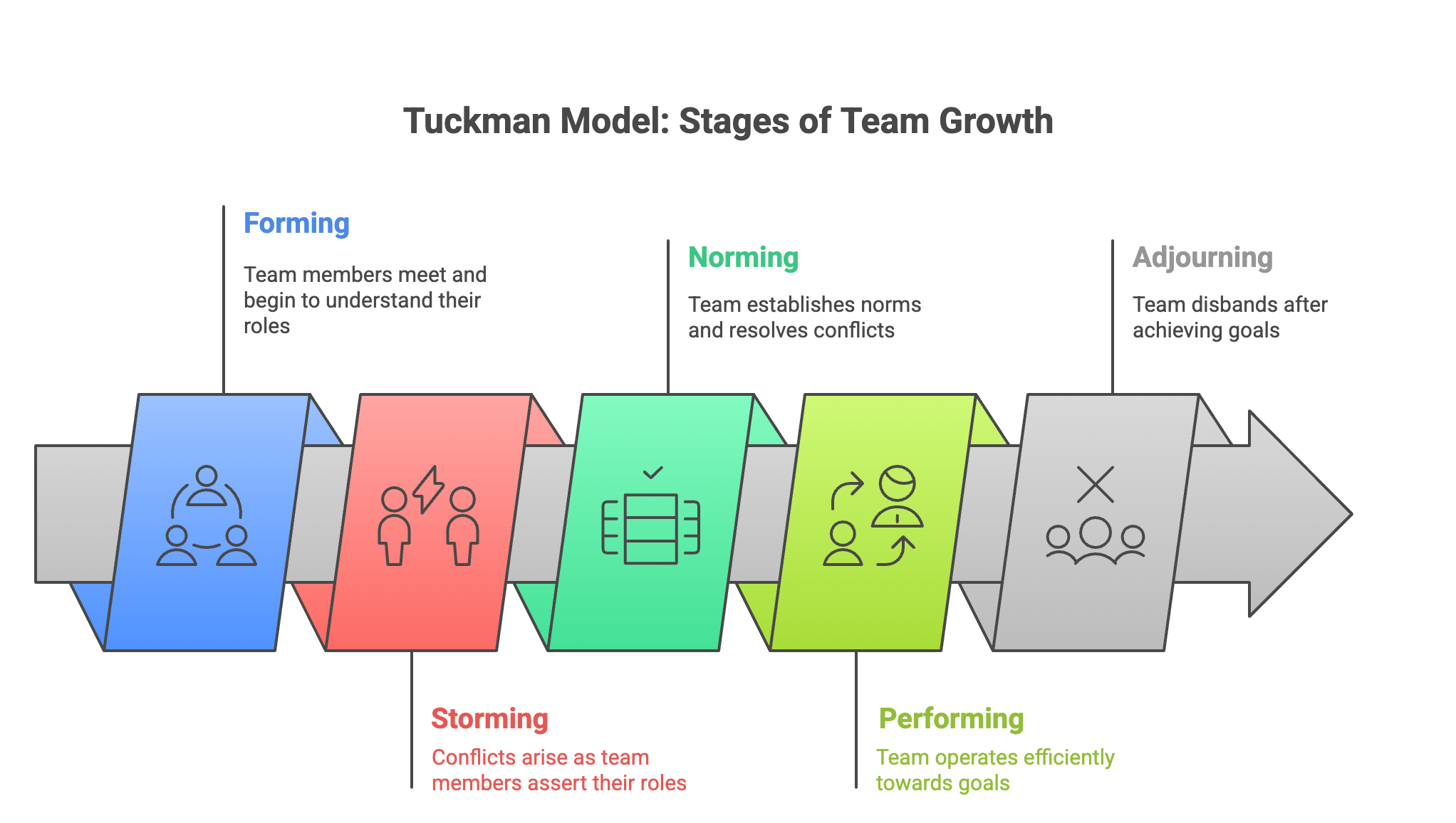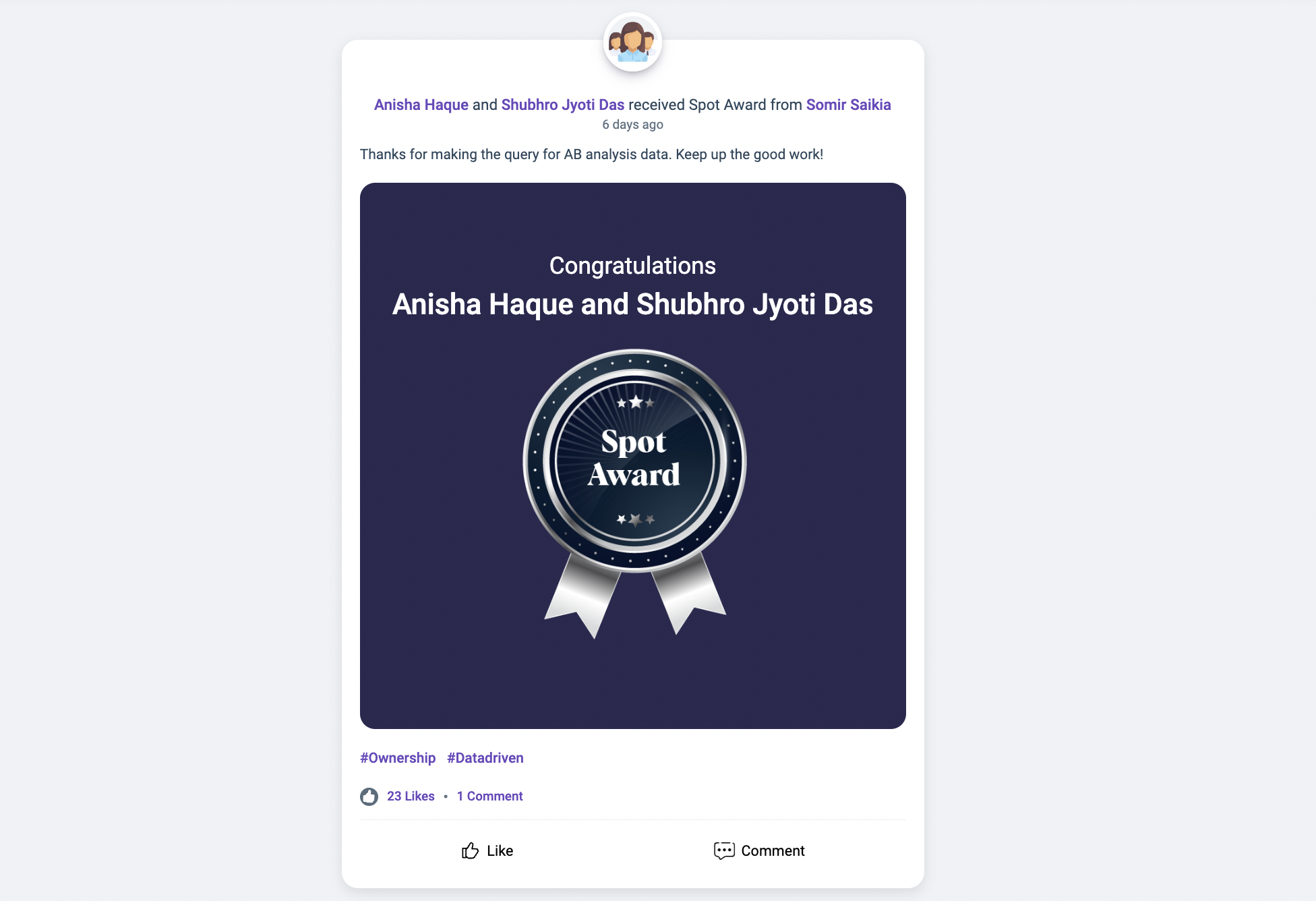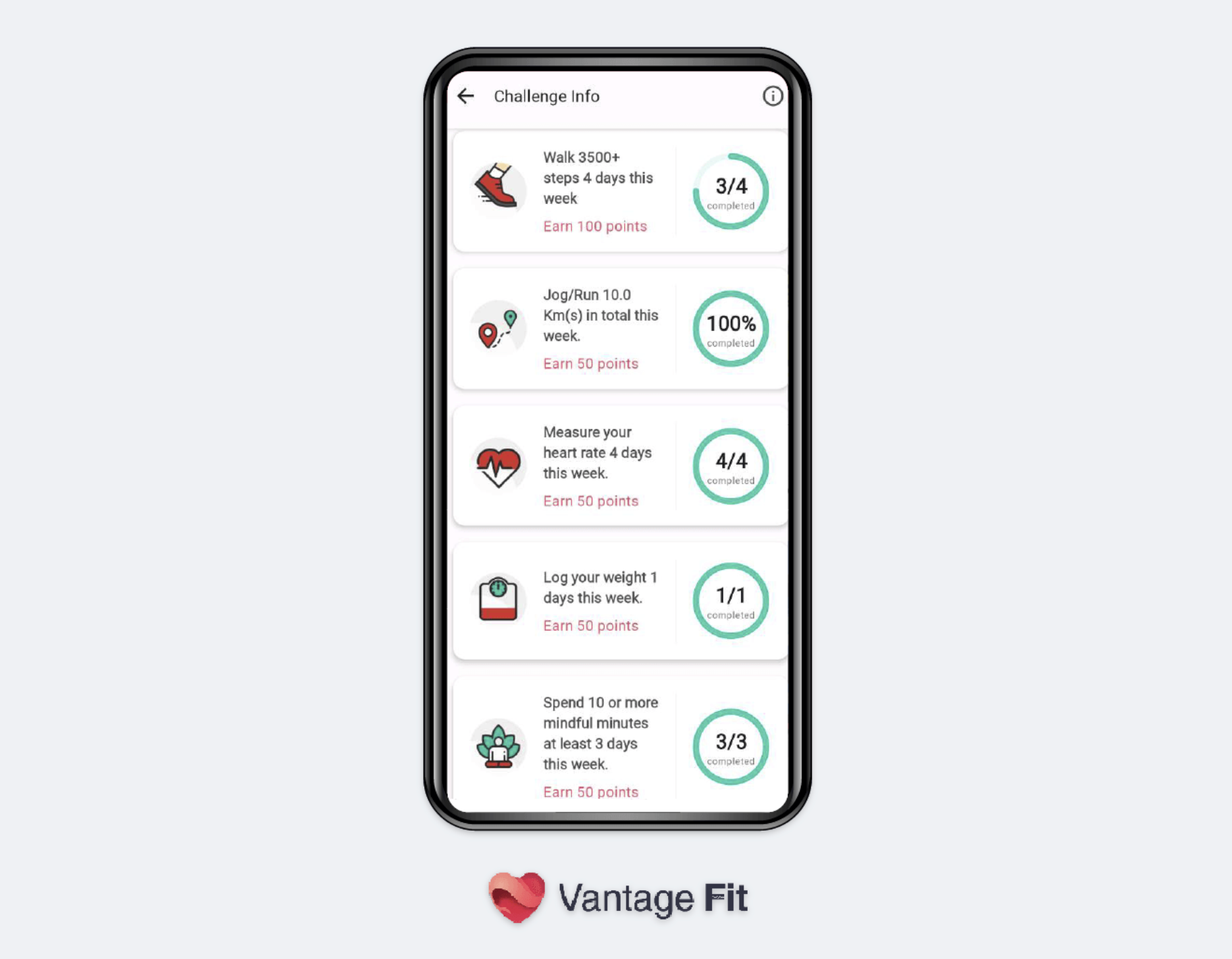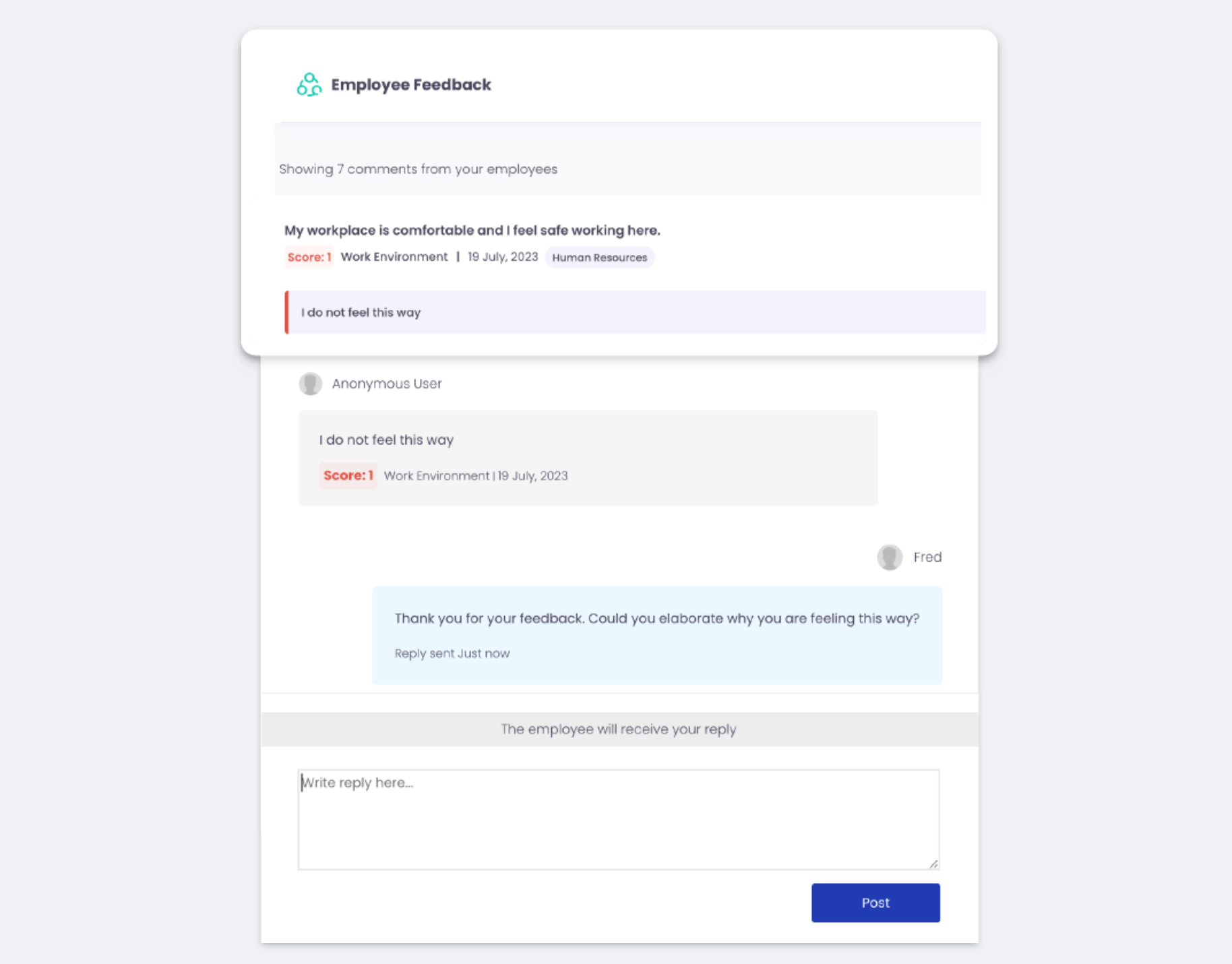Mastering Team Cohesion in the Workplace: Models, Strategies, and Leadership Impact

A Global Employee Recognition and Wellness Platform
What if your organization’s biggest performance gap has nothing to do with strategy, technology, or talent, and everything to do with how well your teams gel? Team cohesion separates winning organizations from struggling ones. Yet most leaders chase shiny strategies while ignoring the invisible force that actually drives results.
Here's what's happening in your organization right now. Some teams click effortlessly and deliver exceptional work. Others stumble through projects despite having talented individuals. The difference isn't skill or resources. It's team cohesion.
Team cohesion creates emotional, relational, and performance alignment. When people genuinely connect and share common goals, everything changes. Decisions happen faster. Problems get solved creatively. People actually want to show up.
The numbers prove this matters for your bottom line. Gallup research shows companies with highly engaged teams experience 21% greater profitability and 17% higher productivity compared to disengaged teams. That's real money leaving the table when teams don't gel.
Most organizations know cohesion matters. Few actually invest in building it systematically. This creates a massive opportunity for leaders who take action.
This guide reveals why cohesion trumps talent every time. You'll discover how to measure what's really happening in your teams and learn battle-tested strategies that transform group dynamics. The companies getting this right are pulling ahead. The question is whether you'll join them.
Key Takeaways
- Concept of Team Cohesion
- Business Impact of Team Cohesion
- 3 Proven Models of Team Cohesion
- The Cohesion Recognition Map
- Actionable Strategies to Improve Team Cohesion in the Workplace
- Leadership's Role in Sustaining Team Cohesion
- Tools and Metrics to Measure Team Cohesion
What Is Team Cohesion (And What It Isn’t)?
Team cohesion refers to the emotional, relational, and performance alignment within a group of individuals. It is the bond that holds team members together, helping them work towards shared objectives with trust, respect, and accountability.
Cohesion goes beyond simple collaboration. It’s about fostering an environment where individuals are genuinely invested in each other’s success and the success of the team as a whole. When a team has strong cohesion, members communicate openly, support each other, and are willing to go the extra mile to help the team reach its goals.
What Team Cohesion Isn’t
While team cohesion is often seen as synonymous with positive work relationships, it's important to distinguish it from related concepts like “team spirit” or “collaboration.” Team cohesion isn’t about being best friends or having a “feel-good” atmosphere; it’s about aligning individual goals with team objectives and building trust that supports high performance.
For instance, a team might work well together in terms of task completion (collaboration), but if there is no emotional connection, mutual respect, or commitment to the team’s success, they might be more compliant than cohesive. This highlights the key difference: cohesion is about emotional investment and trust, while collaboration is more task-oriented.
Key Differences Between Team Cohesion and Related Terms
| Aspect | Team Cohesion | Collaboration | Team Spirit |
|---|---|---|---|
| Definition | Emotional, relational, and performance alignment within a team. | Working together to complete tasks, often without a deep personal connection. | Enthusiasm and positivity within a team, fostering camaraderie. |
| Key Focus | Trust, mutual respect, and shared purpose. | Task completion and efficiency. | Building morale and creating a positive atmosphere. |
| Emotional Investment | High — team members genuinely support each other’s success. | Low to moderate — focus is on tasks, not emotional connection. | Moderate — positive feelings but not necessarily aligned on deeper goals. |
| Impact on Performance | High — teams are resilient and perform better in challenging situations. | Moderate — efficient at task completion but may lack long-term resilience. | Low — may boost morale, but doesn’t ensure sustainable performance. |
| Conflict Handling | Effective — cohesion helps resolve conflict with a focus on mutual success. | Minimal — collaboration doesn’t necessarily involve conflict resolution. | Weak — team spirit alone doesn’t prevent or resolve conflict. |
| Sustainability | Strong — long-lasting as it’s built on deeper trust and commitment. | Weak — can be short-lived if emotional or relational bonds aren’t formed. | Weak — positive morale can dissipate without cohesive bonds. |
Aspect: Definition
Team Cohesion: Emotional, relational, and performance alignment within a team.
Collaboration: Working together to complete tasks, often without a deep personal connection.
Team Spirit: Enthusiasm and positivity within a team, fostering camaraderie.
Aspect: Key Focus
Team Cohesion: Trust, mutual respect, and shared purpose.
Collaboration: Task completion and efficiency.
Team Spirit: Building morale and creating a positive atmosphere.
Aspect: Emotional Investment
Team Cohesion: High — team members genuinely support each other’s success.
Collaboration: Low to moderate — focus is on tasks, not emotional connection.
Team Spirit: Moderate — positive feelings but not necessarily aligned on deeper goals.
Aspect: Impact on Performance
Team Cohesion: High — teams are resilient and perform better in challenging situations.
Collaboration: Moderate — efficient at task completion but may lack long-term resilience.
Team Spirit: Low — may boost morale, but doesn’t ensure sustainable performance.
Aspect: Conflict Handling
Team Cohesion: Effective — cohesion helps resolve conflict with a focus on mutual success.
Collaboration: Minimal — collaboration doesn’t necessarily involve conflict resolution.
Team Spirit: Weak — team spirit alone doesn’t prevent or resolve conflict.
Aspect: Sustainability
Team Cohesion: Strong — long-lasting as it’s built on deeper trust and commitment.
Collaboration: Weak — can be short-lived if emotional or relational bonds aren’t formed.
Team Spirit: Weak — positive morale can dissipate without cohesive bonds.
Why Team Cohesion Matters: Business Impact & Data
Team cohesion is a powerful driver of business performance. Research consistently shows that highly cohesive teams are not only more productive but also enjoy higher levels of trust, faster decision-making, and lower turnover. These outcomes translate into tangible benefits for organizations, making cohesion a key factor in achieving long-term success.
The Business Impact of Team Cohesion
- Higher Trust: Cohesive teams trust each other more deeply, which enables them to communicate openly, share ideas, and make decisions faster. Trust is foundational for collaboration, problem-solving, and innovation.
- Faster Execution: When team members are aligned on goals and values, they can move quickly toward solutions without the delays caused by misunderstandings or miscommunications. Cohesion allows teams to execute strategies more efficiently.
- Lower Attrition: Teams with high cohesion are more likely to retain talent. Employees who feel connected to their team and share a sense of belonging are less likely to leave, reducing turnover costs.
Supporting Data: ROI of Team Cohesion
Forbes reports that highly cohesive teams have a 37% higher likelihood of sustaining workforce health, which correlates with better productivity and morale.
Deloitte’s research notes that 65% of work is now organized around cross-functional teams, where cohesion enables better performance and decision-making.
AIHR notes that teams with high trust and cohesion are more engaged, innovative, and better equipped to handle challenges, directly impacting business performance.
In SHRM’s 2020 report, organizations that foster cohesive teams reported a 50% reduction in voluntary turnover, directly correlating cohesion with improved employee retention (SHRM, 2020).
What are the Proven Models for Team Cohesion
Building team cohesion is a strategic process grounded in decades of organizational research. Three proven frameworks stand out for their practical application and measurable impact:
1. Tuckman’s Stages of Team Development,
2. Lencioni’s Five Dysfunctions of a Team, and the
3. GRPI Model.
Each offers unique insights into how teams form, function, and flourish. What makes these models particularly effective is their emphasis on actionable interventions rather than abstract theory.
Tuckman’s Model: The Five Stages of Team Development

Bruce Tuckman’s framework outlines the natural progression of team dynamics through five distinct stages. Recognizing where a team is in this cycle allows leaders to anticipate challenges and apply targeted recognition strategies that guide teams toward peak performance.
Stage 1: Forming - Building Initial Connections
In this phase, members are cautious, polite, and focused on understanding their place in the group. Anxiety runs high as individuals assess personalities, competencies, and dynamics.
Actionable Insights for the Forming stage:
- Create structured introductions highlighting each member’s expertise.
- Establish clear initial goals and expectations.
- Facilitate informal interactions such as team lunches or coffee chats.
Stage 2: Storming - Navigating Productive Conflict
Friction is inevitable as diverse perspectives clash and power dynamics surface. This discomfort is essential for authentic working relationships.
Actionable Insights for the Storming stage:
- Normalize conflict as a healthy part of team development.
- Set ground rules for constructive disagreement.
- Address personality clashes before they escalate.
Stage 3: Norming - Establishing Team Rhythm
Teams begin to develop shared procedures, communication patterns, and mutual respect. Collaboration becomes natural as strengths are leveraged and weaknesses accommodated.
Actionable Insights for the Norming stage:
- Document emerging best practices and agreements.
- Rotate leadership roles to build collective ownership.
- Create team traditions and rituals.
Stage 4: Performing - Achieving Peak Effectiveness
High-performing teams operate with trust, shared accountability, and seamless coordination. Members anticipate needs, communicate efficiently, and maintain a results focus.
Actionable Insights for the Performing stage:
- Minimize external interference to protect team flow.
- Challenge the team with stretch goals requiring joint effort.
- Share success stories with other teams.
Stage 5: Adjourning - Ensuring Positive Closure
When a project ends or a team disbands, intentional closure helps preserve relationships and capture learnings.
Actionable Insights for the Adjourning stage:
- Conduct retrospectives to identify lessons learned.
- Facilitate knowledge transfer to future teams.
- Maintain professional connections post-project.
Lencioni’s Five Dysfunctions: From Breakdown to Breakthrough

Patrick Lencioni’s pyramid model identifies five common barriers to cohesion and offers a roadmap for transformation. Each dysfunction can be addressed with recognition strategies that reinforce positive behaviors.
1. Absence of Trust - The Foundation Crisis
Teams without trust operate in survival mode. People hide mistakes, avoid asking for help, and waste energy on politics instead of performance.
Actionable Insights:
- Model vulnerability by sharing mistakes and learnings.
- Hold “failure parties” to celebrate lessons from setbacks.
- Track trust metrics in regular assessments.
2. Fear of Conflict - The Harmony Trap
False harmony kills innovation. When teams avoid healthy debate, bad ideas survive and good solutions never surface.
Actionable Insights:
- Train teams in constructive conflict methods.
- Assign rotating “devil’s advocate” roles.
- Distinguish between task conflict and personal conflict.
3. Lack of Commitment - The Clarity Crisis
Without real buy-in, teams drift. Priorities stay fuzzy. Execution feels half-hearted because people never truly agreed to the plan.
Actionable Insights:
- Ensure every voice is heard in decisions.
- Use clear decision-making frameworks.
- Revisit goals regularly for continued commitment.
4. Avoidance of Accountability - The Standards Slip
When nobody calls out poor performance, standards erode. High performers get frustrated and start looking for the exit.
Actionable Insights:
- Set clear performance expectations.
- Build peer accountability alongside manager oversight.
- Conduct regular progress check-ins.
5. Inattention to Results - The Ego Override
Personal agendas poison team success. When individuals prioritize their own goals over collective wins, everyone loses.
Actionable Insights:
- Make results visible through dashboards and updates.
- Link reviews to team achievements.
- Celebrate team wins over individual glory.
GRPI Model: The Four Pillars of Team Excellence

The GRPI framework, which encompasses Goals, Roles, Processes, and Interpersonal Relationships, acts as a diagnostic and improvement tool for team effectiveness.
1. Goals - Creating Shared Direction
The foundation of any cohesive team is a shared vision and clear goals. Without clear goals, teams can quickly become disoriented, leading to confusion, frustration, and a lack of focus.
Actionable Insights:
- Involve the team in goal-setting.
- Break goals into milestones.
- Adjust objectives as needed.
2. Roles - Defining Individual Contributions
In a cohesive team, every member understands their role and the value they bring to the table. When roles are unclear, overlapping responsibilities or missed expectations can cause tension and undermine the team's effectiveness.
Actionable Insights:
- Define interdependent responsibilities.
- Update roles as capabilities shift.
- Address conflicts early.
3. Processes - Optimizing Team Operations
Efficient team processes allow a team to function smoothly and achieve its goals effectively. Teams that fail to define or improve their processes often struggle with bottlenecks, confusion, and wasted time.
Actionable Insights:
- Map workflows and streamline.
- Standardize recurring tasks.
- Review processes regularly.
4. Interpersonal Relationships - Nurturing Human Connections
While goals and processes are important, the relationships within a team are what make it truly cohesive.
Actionable Insights:
- Invest in team-building activities.
- Resolve conflicts early.
- Celebrate diversity.
The Role of Recognition in Building Cohesion
Recognition is often treated as a "feel-good" perk, but it's actually one of the most powerful drivers of team cohesion. When done right, recognition creates psychological safety, strengthens trust, and aligns individuals with team values. It transforms a group of individuals working side by side into a unified, purpose-driven team.
Why Recognition Drives Human Motivation
Recognition taps into fundamental human needs that create the foundation for team cohesion. Understanding these psychological drivers helps leaders use recognition more strategically rather than as an afterthought.
1. Meeting Core Human Needs: Maslow’s Hierarchy of Needs
Maslow's hierarchy shows how recognition addresses multiple levels of human motivation simultaneously. At the belonging level, recognition helps employees feel included and valued as team members. At the esteem level, it validates contributions and builds individual confidence within the group context.
At the self-actualization level, recognition encourages employees to stretch their capabilities, knowing their efforts will be appreciated. Recognition moves employees upward through these needs by fulfilling both social and psychological requirements for engagement.
2. Building Intrinsic Motivation: Self-Determination Theory (SDT)
Self-Determination Theory identifies three core needs that drive sustainable motivation: autonomy, competence, and relatedness. Recognition reinforces ownership of work by acknowledging individual decision-making and initiative. It validates skills and achievements, boosting feelings of mastery and competence.

Source: Vantage Recognition
Most importantly for cohesion, recognition strengthens emotional bonds within teams through the relatedness factor. When recognition practices align with these three needs, they create both individual motivation and team unity through shared purpose and mutual appreciation.
The Cohesion Recognition Map
| Team Stage | Cohesion Challenge | Recognition Focus | Examples |
|---|---|---|---|
| Forming | Establishing belonging and initial trust | Inclusion Recognition | Recognize new members’ skills, publicly welcome them, and celebrate first contributions. |
| Storming | Managing conflict and surfacing differences | Courage & Respect Recognition | Acknowledge members who raise tough questions respectfully, celebrate constructive debate, and highlight conflict resolution wins. |
| Norming | Building routines, norms, and collaboration | Process & Team Recognition | Recognize teams for adopting rituals (e.g., retrospectives), celebrate shared problem-solving, and acknowledge new norms. |
| Performing | Sustaining accountability and high performance | Milestone & Excellence Recognition | Celebrate major team achievements, acknowledge stretch goals, and highlight peer-to-peer accountability moments. |
| Adjourning | Closure, transition, and legacy preservation | Contribution & Legacy Recognition | Recognize both individuals and the group with memory artifacts (scrapbooks, video highlights), honor knowledge transfer, and celebrate impact. |
Team Stage: Forming
Cohesion Challenge: Establishing belonging and initial trust
Recognition Focus: Inclusion Recognition
Examples: Recognize new members’ skills, publicly welcome them, and celebrate first contributions.
Team Stage: Storming
Cohesion Challenge: Managing conflict and surfacing differences
Recognition Focus: Courage & Respect Recognition
Examples: Acknowledge members who raise tough questions respectfully, celebrate constructive debate, and highlight conflict resolution wins.
Team Stage: Norming
Cohesion Challenge: Building routines, norms, and collaboration
Recognition Focus: Process & Team Recognition
Examples: Recognize teams for adopting rituals (e.g., retrospectives), celebrate shared problem-solving, and acknowledge new norms.
Team Stage: Performing
Cohesion Challenge: Sustaining accountability and high performance
Recognition Focus: Milestone & Excellence Recognition
Examples: Celebrate major team achievements, acknowledge stretch goals, and highlight peer-to-peer accountability moments.
Team Stage: Adjourning
Cohesion Challenge: Closure, transition, and legacy preservation
Recognition Focus: Contribution & Legacy Recognition
Examples: Recognize both individuals and the group with memory artifacts (scrapbooks, video highlights), honor knowledge transfer, and celebrate impact.
What Drives (or Destroys) Team Cohesion?
Team cohesion isn't static. It thrives when certain conditions are met and quickly deteriorates when they're absent. Understanding the drivers and destroyers of cohesion helps leaders create environments where teams not only collaborate but excel.
Key Drivers of Team Cohesion
Trust forms the cornerstone of any cohesive team. Without it, collaboration becomes forced, and employees hold back their true potential. Cohesive teams are built on psychological safety, where members can express themselves without fear of embarrassment or retaliation.
Google's Project Aristotle found psychological safety to be the single most important factor in high-performing teams. This research validates what many leaders intuitively know: trust enables everything else.
Open communication ensures alignment on goals and prevents misunderstandings. Transparent, two-way communication strengthens cohesion when members actively listen and share feedback constructively. Poor communication creates confusion and resentment that fragments teams quickly.
Shared goals and purpose create alignment across diverse perspectives. Teams rally together when they see the bigger picture and understand how their work contributes to meaningful outcomes. Ambiguity fractures trust and slows execution.
Leadership influence sets the tone for everything that follows. Inclusive leaders foster belonging while micromanagement or favoritism erodes trust. Leaders who recognize contributions, mediate conflicts, and model collaboration play a pivotal role in sustaining cohesion.
Technology can enhance collaboration when implemented thoughtfully. Tools like Slack, Notion, or Zoom keep communication transparent and centralized. However, fragmented or poorly implemented tools become blockers that create silos and frustration.
What Destroys Team Cohesion
Lack of trust turns teams into political battlegrounds. Without trust, members withhold ideas and focus on self-preservation rather than collaboration. Teams devolve into finger-pointing and blame games.
Poor communication creates misalignment and hidden agendas. Unclear instructions or silence can be as damaging as open conflict when team members don't feel heard. Information hoarding destroys cohesion faster than most other factors.
Unclear roles and goals lead to duplicated efforts and conflict over ownership. Teams without clarity on responsibilities and purpose often burn out quickly. Ambiguity creates gaps that no one fills and overlaps that cause friction.
Toxic leadership behaviors corrode team morale systematically. Leaders who micromanage, play favorites, or avoid accountability cause employees to disengage. Unfairness and inconsistency poison team dynamics.
Overreliance on tools replaces human connection with digital noise. Too many tools without clear protocols create communication overload and siloed conversations. Technology should enable cohesion, not replace it.
Actionable Strategies to Improve Team Cohesion in the Workplace
Models and theories provide the blueprint, but cohesion is built through everyday actions. The most successful teams embed cohesion-building habits into their regular workflow, making it part of the culture rather than a one-off activity.
1. Build Trust Through Transparency
Share team goals, decisions, and metrics openly so everyone understands the bigger picture. Encourage leaders to model vulnerability by admitting mistakes and seeking feedback from their teams.
Publish decisions in shared spaces like Slack channels or Notion pages where everyone can access them. This prevents information silos and shows that leadership has nothing to hide from the team.
2. Establish Team Rituals
Create recurring practices such as weekly check-ins, retrospective meetings, or celebrating small wins every Friday. Rituals anchor a sense of stability and belonging, especially important for hybrid and remote teams.
MIT's Human Dynamics Lab found that teams with consistent rituals and informal interactions perform significantly better than those without structured connection points. Regular touchpoints create predictable opportunities for relationship building.
3. Encourage Cross-Generational Mentoring
Implement reverse mentoring where younger employees coach senior colleagues on technology trends while senior employees provide career wisdom. This approach breaks down silos across age groups and fosters mutual respect.
Cross-generational mentoring enriches team culture with diverse perspectives and creates unexpected learning opportunities for everyone involved. It transforms potential generational tension into collaborative advantage.
4. Recognize Shared Wins, Not Just Individual Efforts
Balance individual recognition with team recognition to shift focus from "me" to "we." After a successful product launch, celebrate not just the designers or engineers but the entire cross-functional team that made it possible.

Source: Vantage Recognition
Collective recognition reinforces that success comes from collaboration rather than individual heroics. This builds investment in each other's success rather than competition between team members.
5. Use Gamification to Boost Engagement
Introduce friendly competitions like wellness challenges, innovation sprints, or peer-recognition leaderboards. Gamification taps into intrinsic motivation and makes teamwork genuinely enjoyable.

Source: Vantage Fit Gamified Wellness Challenge
The key is keeping competition light and ensuring everyone can participate regardless of skill level or role.
6. Foster Psychological Safety
Create a "no-blame" environment where mistakes are treated as learning opportunities rather than failures. Establish ground rules that normalize constructive conflict while discouraging personal attacks.
Cohesion is strongest when members feel safe enough to experiment and fail without fear of punishment. This connects directly to Google's Project Aristotle findings on what makes teams truly effective.
7. Strengthen Connections Beyond Work
Organize activities such as team fitness challenges, volunteering, or casual coffee catch-ups that help colleagues see each other as whole people. For remote teams, virtual trivia or shared Slack channels for hobbies create informal bonding opportunities.
Social connections outside work tasks build the personal relationships that make professional collaboration more natural and enjoyable. These connections become the foundation that helps teams weather difficult periods together.
Leadership's Role in Sustaining Cohesion
Team cohesion doesn't emerge organically. It's nurtured and sustained by leadership that acts as the cultural architect, modeling behaviors and creating alignment that either strengthens or erodes team bonds.
Leaders as Role Models
Cohesion starts at the top and flows downward through every interaction. When leaders demonstrate openness, fairness, and accountability, team members mirror those behaviors naturally.
Toxic leadership behaviors like micromanagement, favoritism, or conflict avoidance quickly destroy trust. Transformational leaders who inspire and empower rather than control consistently build stronger team bonds and higher collective performance.
Building Alignment and Shared Purpose
Strong leaders create clarity by consistently reinforcing the "why" behind the work. They connect team goals to the organization's mission and ensure every member sees how their contribution matters to the bigger picture.
Begin meetings by restating how team objectives tie back to company values or long-term strategy. This alignment strengthens cohesion by keeping everyone pointed in the same direction with shared understanding.
Resolving Conflict Constructively
Conflict is inevitable in healthy teams, but unresolved conflict corrodes relationships quickly. Leaders sustain cohesion by ensuring disagreements are addressed early, fairly, and productively rather than being swept under the rug.
Train leaders in conflict mediation techniques and normalize feedback loops where concerns can be raised without fear of reprisal. Early intervention prevents small issues from becoming team-destroying problems.
Embedding Diversity, Equity, and Inclusion
Cohesion thrives when teams feel inclusive and equitable for everyone involved. Leaders who prioritize DEI build psychologically safe environments where different voices are heard and valued equally.
Recognize contributions from underrepresented voices and rotate opportunities to lead discussions or projects.
Using Recognition as a Leadership Tool
Recognition is one of the simplest yet most powerful tools leaders have to sustain cohesion across different team development phases. During conflict periods, recognition can validate respectful disagreement and problem-solving efforts.
In established teams, recognition reinforces positive behaviors and celebrates shared wins to keep motivation high. By making recognition a regular leadership practice rather than an annual event, cohesion becomes self-sustaining over time.
Leadership Styles That Foster Cohesion
Transformational leadership inspires through vision and recognition of individual efforts within team success. Servant leadership builds cohesion by prioritizing team needs above personal authority or ego.
Inclusive leadership strengthens cohesion by actively seeking diverse input and ensuring equity in recognition and opportunities. The most effective leaders adapt their style to what their specific team needs most.
Measuring Team Cohesion: Tools & Metrics
Building cohesion is only half the battle. Sustaining it requires regular measurement and feedback loops to catch underlying issues before they erode trust and performance.
1. Pulse Surveys
Short, frequent surveys capture real-time insights on trust, communication, and belonging better than annual engagement surveys. Pulse surveys provide immediate feedback that helps leaders act on problems before they escalate into bigger issues.

Source: Vantage Pulse
Use questions like "I feel that my team has my back when challenges arise" to gauge psychological safety. Tools like Vantage Pulse specialize in quick, anonymous pulse surveys that highlight team sentiment trends over time.
2. Employee Net Promoter Score (eNPS)
eNPS measures the likelihood that employees would recommend their workplace to others. Teams with strong bonds are more likely to endorse their organization, making eNPS a powerful proxy for cohesion.
Track eNPS quarterly to monitor trends and pair it with open-text questions to understand the reasoning behind scores. Declining eNPS often signals eroding trust or belonging before other symptoms appear.
3. Feedback Loops
Regularly scheduled check-ins, retrospectives, or open forums provide qualitative data that complements survey results. These conversations add nuance to the numbers and surface specific issues that surveys might miss.
Use structured retrospectives like "Start, Stop, Continue" to surface actionable insights from team members. The key is creating safe spaces where people feel comfortable sharing honest feedback.
4. Collaboration Metrics
Digital collaboration tools generate data on communication frequency, response times, and interaction patterns across team members. Analysis of these patterns reveals whether a team is working inclusively or operating in silos.
Use collaboration analytics to measure team patterns, not individual performance, to avoid creating a micromanagement environment. Focus on identifying communication gaps or excluded team members rather than productivity surveillance.
5. Advanced Engagement Platforms
CultureAmp provides science-backed surveys and analytics to measure engagement, belonging, and team health with benchmarking against similar organizations. Glint offers real-time people success platforms that measure sentiment and link it to performance outcomes.
Peakon tracks employee engagement drivers and flags areas where cohesion may be breaking down. These platforms combine multiple data sources to provide comprehensive views of team dynamics.
6. How to Interpret Results
Declining eNPS may indicate eroding trust or belonging that needs immediate attention. Low scores in team support items often reflect a lack of psychological safety that requires leadership intervention.
Spikes in voluntary turnover signal weak cohesion, especially when paired with low survey scores in trust or communication areas. Look for patterns across metrics rather than relying on single data points to guide decisions.
The Road Ahead: Building Cohesion That Lasts
Team cohesion isn't a one-time fix. It's an ongoing investment that compounds over time.
Focus on four pillars: trust, communication, empowerment, and inclusion. When you celebrate these behaviors consistently, teams choose collective success over individual wins.
The frameworks we've covered give you proven roadmaps. Tuckman reveals team evolution. Lencioni exposes hidden barriers. GRPI helps diagnose real problems from perceived ones.
But frameworks are just tools. Real cohesion happens when people genuinely want to succeed together. This means building respect into daily work, making collaboration feel natural, and giving everyone a shared purpose worth pursuing.
Organizations that master this approach build lasting competitive advantages. Their people stay longer, perform better, and actually enjoy the work.
The question isn't whether cohesion matters. It's whether you'll commit to building it.
FAQs on Team Cohesion
Q1. What is team cohesion in the workplace?
Team cohesion is the emotional, relational, and performance alignment that bonds individuals together. It ensures teams work collaboratively, support each other, and stay committed to shared goals.
Q2. Why is team cohesion important for organizations?
Cohesive teams are more productive, innovative, and resilient. They experience higher trust, lower turnover, and faster execution compared to teams without cohesion.
Q3. How can you measure team cohesion?
You can measure cohesion using tools like pulse surveys, eNPS, retrospectives, and engagement platforms (e.g., CultureAmp, Officevibe). These track trust, communication, and team alignment.
Q4. Can you measure cohesion in hybrid or remote teams?
Yes. Pulse surveys, digital collaboration metrics, and virtual feedback loops make it possible to assess cohesion in hybrid teams. Informal virtual rituals also reveal team bonding levels.
Q5. Does team cohesion reduce turnover?
Yes. Research shows cohesive teams report stronger retention. Employees who feel supported and valued within their team are less likely to leave.
















